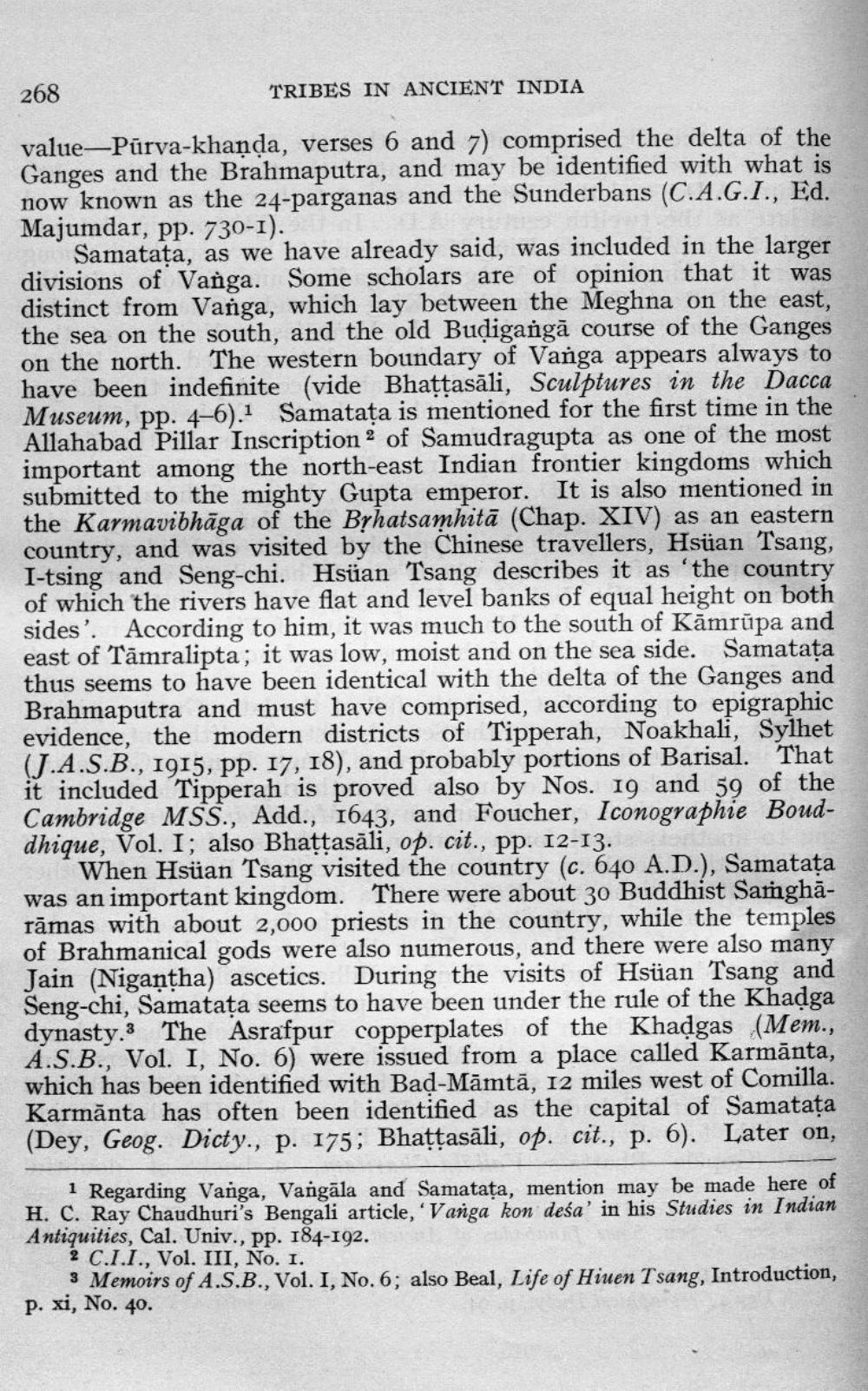________________
268
TRIBES IN ANCIENT INDIA
value-Pūrva-khanda, verses 6 and 7) comprised the delta of the Ganges and the Brahmaputra, and may be identified with what is now known as the 24-parganas and the Sunderbans (C.A.G.I., Ed. Majumdar, pp. 730-1).
Samatata, as we have already said, was included in the larger divisions of Vanga. Some scholars are of opinion that it was distinct from Varga, which lay between the Meghna on the east, the sea on the south, and the old Budigangā course of the Ganges on the north. The western boundary of Vanga appears always to have been indefinite (vide Bhattasāli, Sculptures in the Dacca Museum, pp. 4–6).1 Samataţa is mentioned for the first time in the Allahabad Pillar Inscription of Samudragupta as one of the most important among the north-east Indian frontier kingdoms which submitted to the mighty Gupta emperor. It is also mentioned in the Karmavibhāga of the Byhatsamhitā (Chap. XIV) as an eastern country, and was visited by the Chinese travellers, Hsüan Tsang, I-tsing and Seng-chi. Hsüan Tsang describes it as 'the country of which the rivers have flat and level banks of equal height on both sides'. According to him, it was much to the south of Kāmrūpa and east of Tāmralipta; it was low, moist and on the sea side. Samatata thus seems to have been identical with the delta of the Ganges and Brahmaputra and must have comprised, according to epigraphic evidence, the modern districts of Tipperah, Noakhali, Sylhet (J.A.S.B., 1915, pp. 17, 18), and probably portions of Barisal. That it included "Tipperah is proved also by Nos. 19 and 59 of the Cambridge MSS., Add., 1643, and Foucher, Iconographie Bouddhique, Vol. I; also Bhattasāli, op. cit., pp. 12-13.
When Hsüan Tsang visited the country (c. 640 A.D.). Samatata was an important kingdom. There were about 30 Buddhist Samghārāmas with about 2,000 priests in the country, while the temples of Brahmanical gods were also numerous, and there were also many Jain (Nigantha) ascetics. During the visits of Hsuan Tsang and Seng-chi, Samatata seems to have been under the rule of the Khadga dynasty.3 The Asrafpur copperplates of the Khadgas (Mem., A.S.B., Vol. I, No. 6) were issued from a place called Karmānta, which has been identified with Bad-Māmtā, 12 miles west of Comilla. Karmānta has often been identified as the capital of Samataţa (Dey, Geog. Dicty., p. 175; Bhattasāli, op. cit., p. 6). Later on,
1 Regarding Vanga, Vangāla and Samatata, mention may be made here of H. C. Ray Chaudhuri's Bengali article, 'Vanga kon deśa' in his Studies in Indian Antiquities, Cal. Univ., pp. 184-192.
2 C.I.I., Vol. III, No. I.
3 Memoirs of A.S.B., Vol. I, No. 6; also Beal, Life of Hiuen Tsang, Introduction, p. xi, No. 40.




